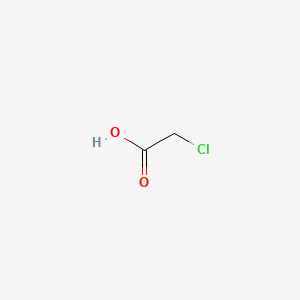| MeSH term | MeSH ID | Detail |
|---|---|---|
| Anemia | D000740 | 21 associated lipids |
| Bird Diseases | D001715 | 4 associated lipids |
| Body Weight | D001835 | 333 associated lipids |
| Brain Edema | D001929 | 20 associated lipids |
| Burns, Chemical | D002057 | 3 associated lipids |
| Cell Transformation, Neoplastic | D002471 | 126 associated lipids |
| Solitary Pulmonary Nodule | D003074 | 1 associated lipids |
| Death, Sudden | D003645 | 12 associated lipids |
| Eosinophilic Granuloma | D004803 | 1 associated lipids |
| Factor XIII Deficiency | D005177 | 1 associated lipids |
2-chloro-acetic acid
2-chloro-acetic acid is a lipid of Fatty Acyls (FA) class.
Cross Reference
There are no associated biomedical information in the current reference collection.
Current reference collection contains 1900 references associated with 2-chloro-acetic acid in LipidPedia. Due to lack of full text of references or no associated biomedical terms are recognized in our current text-mining method, we cannot extract any biomedical terms related to diseases, pathways, locations, functions, genes, lipids, and animal models from the associated reference collection.
Users can download the reference list at the bottom of this page and read the reference manually to find out biomedical information.
Here are additional resources we collected from PubChem and MeSH for 2-chloro-acetic acid
Possible diseases from mapped MeSH terms on references
We collected disease MeSH terms mapped to the references associated with 2-chloro-acetic acid
PubChem Biomolecular Interactions and Pathways
NCBI Entrez Crosslinks
All references with 2-chloro-acetic acid
Download all related citations| Authors | Title | Published | Journal | PubMed Link |
|---|---|---|---|---|
| Kim S and Picardal FW | A novel bacterium that utilizes monochlorobiphenyls and 4-chlorobenzoate as growth substrates. | 2000 | FEMS Microbiol. Lett. | pmid:10754252 |
| Dartsch PC et al. | Sodium monochloroacetate causes cytotoxic effects, an increased lactate and pyruvate level and induces ultra structural and cytoskeletal alterations in cultured kidney and liver epithelial cells. | 2000 | Hum Exp Toxicol | pmid:10773845 |
| Inman JK | Thymus-independent antigens: the preparation of covalent, hapten-ficoll conjugates. | 1975 | J. Immunol. | pmid:1079035 |
| Friend DS et al. | Senescent jejunal mast cells and eosinophils in the mouse preferentially translocate to the spleen and draining lymph node, respectively, during the recovery phase of helminth infection. | 2000 | J. Immunol. | pmid:10861071 |
| Bennett JM et al. | Hypergranular promyelocytic leukemia: correlation between morphology and chromosomal translocations including t(15;17) and t(11;17). | 2000 | Leukemia | pmid:10914542 |
| Bartsch H et al. | Human, rat and mouse liver-mediated mutagenicity of vinyl chloride in S. typhimurium strains. | 1975 | Int. J. Cancer | pmid:1095499 |
| Rozman KK | The role of time in toxicology or Haber's c x t product. | 2000 | Toxicology | pmid:10963859 |
| Abdel-Gawad SM et al. | Synthesis and antifungal activity of novel pyrano[2',3':4,5]thiazolo[2,3-b]quinazolines, pyrido[2',3':4,5]thiazolo[2,3-b]quinazolines and pyrazolo[2',3':4,5]thiazolo[2,3-b]quinazolines. | 2000 | Farmaco | pmid:10966160 |
| Yam LT et al. | Differential characterization of the "reticulum cell" in lymphoreticular neoplasms. | 1975 | Am. J. Clin. Pathol. | pmid:1098440 |
| Durán Merás I et al. | Complexation of antibacterial quinolonic acid and cinolonic derivatives with Zn(II) and Al(III): application to their determination in human urine. | 2000 | Analyst | pmid:11002930 |
